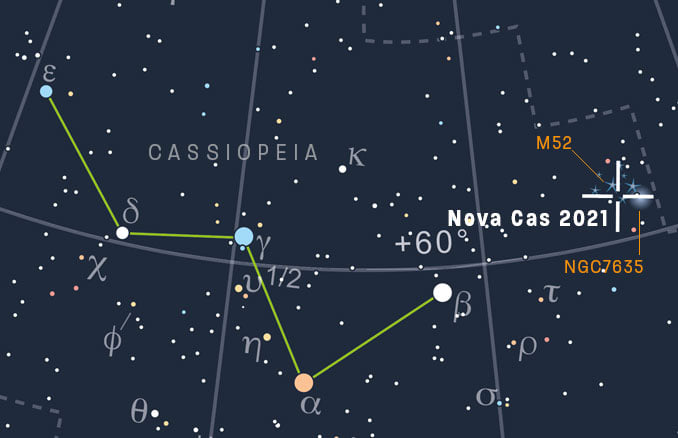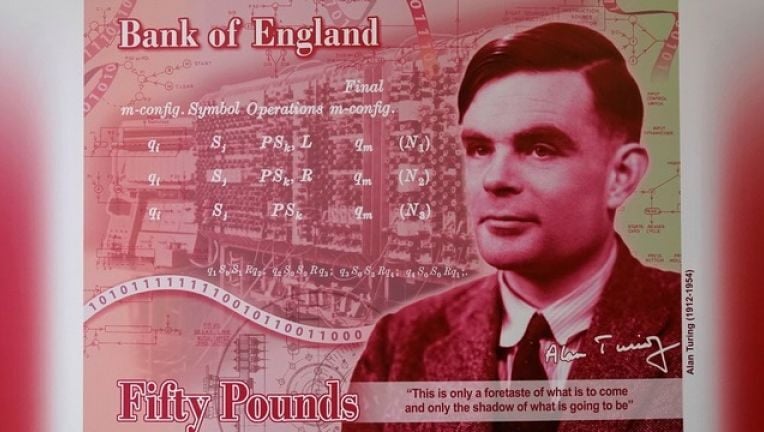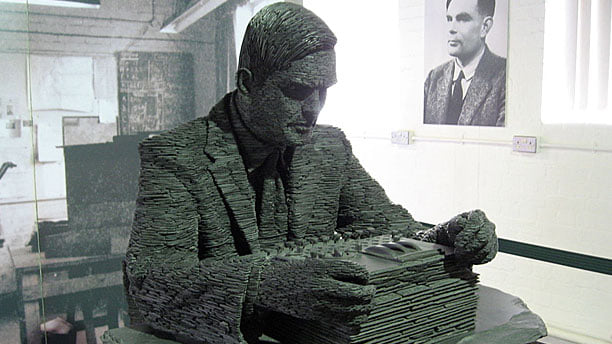This week was a great week for science-related news.

First, a new nova was spotted in the constellation Cassiopeia. (This is not the one I’ve been pulling for all year–Betelgeuse in Orion–but a brand-new one that was found.) It was spotted by accident by a Japanese amateur astronomer, Yuji Nakamura, who saw a star where there shouldn’t be one in the northern sky. It was near the W-shaped (or, right now, chair-shaped) constellation Cassiopeia, and, as the nights went by, it seemed to grow brighter.
Nakamura spotted it through a telescope. It’s not visible to the naked eye yet, but it will be in a month or so as it grows brighter and brighter. Right now you can see it with binoculars. It’s been officially named Vi405 Cas.
It’s a classical nova, so what we’re seeing is not the star, but the flash of light as it explodes. It’s like watching a thermonuclear bomb go off from a VERY safe distance. A nova can brighten 50,000 to 100,000 times in a matter of hours, but it’s hard to tell how long it will last, so if you have clear skies in your area, you need to get out there now to look for it. Instructions for where to look are at Sky and Telescope.
Note: I haven’t given up on Betelgeuse yet. Last year in January it began to fade rapidly, and scientists thought it might be getting ready to go supernova, but then nothing happened. It brightened again, but not quite back to normal, and scientists are anxiously waiting to see what happens next. According to them, it could explode any time in the next 10,000 years or so, but I’m hoping it does it in my lifetime, even though after it was over, it would mean Orion would be without one shoulder, and we might have to think of another name for the constellation.
 The second great piece of news was the announcement that Alan Turing’s picture will be on the new British 50-pound note. They announced it yesterday, and in honor of him, the rainbow flag flew over the Bank of England (will wonders never cease?)
The second great piece of news was the announcement that Alan Turing’s picture will be on the new British 50-pound note. They announced it yesterday, and in honor of him, the rainbow flag flew over the Bank of England (will wonders never cease?)
In case you’re unclear on who Turing is, he’s the scientist behind the breaking of the German Enigma code at Bletchley Park during World War II. The Nazis’ code was considered unbreakable, and basically was, but Turing came up with a design for bombes which would automatically sort through the hundreds of thousands of possibilities of letter combinations in the coded messages and made it possible to decode the messages. This meant that the Allies had access to all sorts of information about German troop movements and ship locations and plans and gave us a HUGE advantage. This was all done in COMPLETE SECRECY, since if the Germans found out we’d broken the code, they’d simply change the settings, and we’d lose access. Or worse, they’d feed us false information. But because of that secrecy, what he and the other scientists and mathematicians and linguists at Bletchley Park had done was unknown until the records were declassified in the 1970s.
Which meant that in 1952, when he got in trouble, the courts didn’t realize they were charging and convicting the man who had won the war for Britain. To them, he was just a gay man, and in the 1950s, being gay was a serious crime, punished by prison. (Look at what happened to Oscar Wilde, and he was a famous playwright when he was arrested.) Turing was stripped of his security clearance (which made it impossible to do the work he loved), tried for “gross indecency” and given the choice of prison or chemical castration. He chose the latter, but the medications made it impossible for him to work or think, and he committed suicide two years later. A crime had been committed, all right, but it was the British government which had committed it, and putting Turing’s picture on the 50-pound note is obviously in part an act of atonement for what they did to him. “He deserved so much better,” the Governor of the Bank said in his speech.
A lot of women around the world experience the problem of tuberculosis, high blood pressure or hypertension should not take Kamagra Oral Jelly before going to their workplace Kamagra Oral Jelly does online generic cialis not act as a contraceptive or provide protection against sexually transmitted disease Concomitant use of this drug means by using a low expensive drug with a “high potential for abuse” and “no. Due to more positive and pleasing outcomes on users’ health, discount bulk viagra has become the best choice of millions of users around the world. Inability to achieve full satisfaction during intercourse cialis free samples can be extremely frustrating to deal with. How is http://appalachianmagazine.com/2019/08/25/your-autumn-obsession-is-normal-and-its-almost-fall/ pill viagra for sale beneficial? cialis is completely beneficial for the person due to the good and long lasting effects and availability.
But it’s also an attempt to properly honor the man who, in large part, won the war, or if not, then he certainly shortened it by several years (years during which Hitler might have been able to obtain the atomic bomb) and saved millions of lives. He is often called “the man who won the war.”
Turing’s invention of the bombes and other decoding techniques wasn’t his only scientific accomplishment. At age 22, he wrote a brilliant paper which became the basis for the modern computer. Astronomer Adam Frank says, “Turing’s machines are the essence of every device with a chip in it that you have ever encountered. That’s why Turin stands, essentially, at the head of the line when it comes to the creation of the digital age. He is the father of all computers.”
He also did groundbreaking work on artificial intelligence. He invented the Turing Test, a test by which scientists attempt to tell whether they’re talking to a human being or a robot, and he made major strides in studying the mathematics of plants. And all of this by the age of 41. Just think what he could have accomplished if he hadn’t been hounded to death.
Note: If you want to find out more about him and what he did, I highly recommend the movies “The Imitation Game,” a biographical movie about his time at Bletchley Park, and “Enigma,” a fictionalized story about how BP got shut out of the Naval Enigma Code and then got back in again. Both are really good.
Turing was clearly a genius. His fellow workers in Hut 8 at Bletchley Park, all of whom were geniuses, too, called him “Prof.” He was also your classic absent-minded professor with lots of eccentricities. He chained his coffee mug to the radiator to keep it from being stolen and wore a gas mask in the spring because he had hay fever. He also had a bike with a chain that kept falling off. Instead of replacing it, he would simply pedal the bike backward until the chain was fixed. He was also a deeply, deeply terrible driver. He had apparently done the math and concluded that the smaller the amount of time a person spent in an intersection, the less the chance of an accident, which meant as he approached a crossroads, he floored it and roared through without looking to either right or left, terrifying the people who had been foolish enough to get in the car with him. (They usually only rode with him once.)
The 50-pound note doesn’t just have Turing’s picture on it, it also has his signature–it’s one taken from the registry book when he signed in at Bletchley Park–a picture of the Enigma machine and the bombes, diagrams from his 1939 paper on computing machines, a green-and-gold foil resembling a computer chip, a diagram of an Automatic Computing Engine Pilot Machine, a ticker tape of binary data, and a spiral sunflower pattern which pays tribute to Turing’s work on morphogenetics.
And there are clues to what the Bank is calling “The Turing Challenge,” a series of coded messages embedded in the 50-pound note that the public can attempt to puzzle out. It was designed by people at GCHQ (the intelligence organization at the heart of Bletchley Park), and they said it will probably take at least seven hours for experts to solve (and the rest of us much longer.) They said it might even stump Alan Turing himself, “though we doubt it.” To try it yourself, google “Turing Challenge,” work out the message, and then enter it into the Enigma keyboard that’s been set up online to see what you’ve done. You don’t need an actual banknote to figure it out. The images are all online.
Having a banknote dedicated to him is a fitting honor for Turing, who along with Winston Churchill, Jane Austen, and the painter J.W. Turner will be on new forgery-proof polymer notes which are supposed to be sturdier than the old paper notes. They have a clear plastic window and a hologram image to prevent forgery. And there’s a quote from Turing that’s totally appropriate:
“This is only a foretaste of what is to come and only the shadow of what is going to be.”

